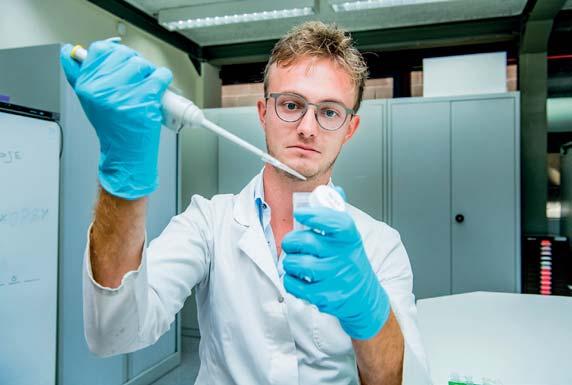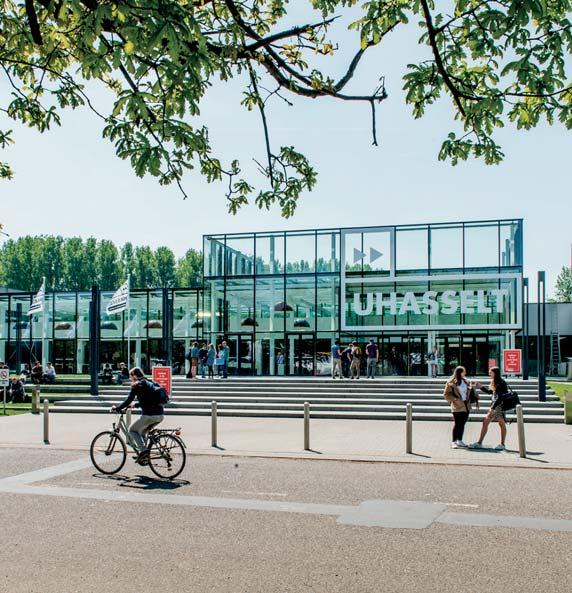
5 minute read
33
by 5rXobdlLrFp
An interview with Prof. dr. Piet STINISSEN, Dean of the faculty of Medicine and Life Sciences at UHasselt
Advertisement
What is the training offer of the faculty of Medicine and life sciences at UHasselt? Our faculty organizes a bachelor - master program in biomedical sciences and a bachelor in medicine. Our master in biomedical sciences is organized in four different subspecialties: molecular mechanisms of health and disease, environmental health sciences, bioelectronics and nanotech nology, and clinical biomedical sciences. In addition we are involved in the education master’s program to train future teachers in health sciences; and we are a partner in an interuniversity program in global health. In total there are around 800 students in our faculty. Our faculty has recently set up a ‘patient embassy’ where patients are guided to play an active role in our education program. PhD programs are offered to biomedical, medical and life sciences students in our doctoral school of Medicine and Health Sciences.
Could you introduce the research activities of the faculty? Our research is organized in four research groups and capacity groups that participate in the Biomedical Research Institute (BIOMED), the Limburg Clinical Research Center (LCRC) and an interdisciplinary research group on patient safety.
The BIOMED Institute is one the four main research institutes of UHasselt and focuses on preclinical and translational research on autoimmune diseases, neuroscience and cardiovascular diseases. BIOMED has a strong international reputation in multiple sclerosis (MS) research. Together with MS hospital in Overpelt we have developed the MS Network Limburg which brings together basic and clinical research, clinical trials and patient care in MS. The two main regional hospitals (ZOL in Genk and Jessa in Hasselt) are our partners in the LCRC. This center was recently developed and brings together patient oriented clinical research in different themes including oncology, cardiology, infections, gynecology, neurology and orthopedics. The Mobile Health Unit is a successful technology platform of LCRC where new mobile and e-health technologies are clinically validated and embedded in patient care in cardiology and the treatment of infertility. © UHasselt
Our patient safety researchers analyze the patient safety culture in Belgian hospitals and together with colleagues from the faculty of economy they perform research on new methodologies to improve patient safety in our healthcare system. All of our research topics are closely linked to our education through projects and internships.
Could you give us a few examples of ongoing research projects at the faculty? Our MS researchers in BIOMED have recently described a new pathway in the brain that could open possibilities for treatment of progressive MS. A mechanism was found that could enhance myelination in the central nervous system (CNS). This work, carried out by the team of Prof. dr. Tim Vanmierlo, showed promising results in an animal model of MS. Still these results need to be translated to the clinic in future studies. Further information can be found here: https://www.flanders.bio/en/news/ flandersbio-member-news/2019/september/promising-step-inresearch-towards-a-treatment-for-progressive-ms/
Together with researchers from the center of environmental health sciences (Prof. dr. Tim Nawrot), our researchers at BIOMED (Prof. dr. Marcel Ameloot, Dr. Hannelore Bove) recently developed a


© UHasselt

new method to identify pollution (soot) in blood and other human tissues. This method was recently applied and lead to the identification of soot in placenta, indicating that pollution may affect children before birth through transmission via placenta. More information: https://www.theguardian.com/environment/2019/ sep/17/air-pollution-particles-found-on-foetal-side-of-placentas-study
Our Mobile Health researchers (part of LCRC, http://mobilehealthunit.org/) are working together with several clinical and technology partners to develop new mhealth applications. Projects together with the Belgian ministry of health have led to the approval of new apps that are now used in the Belgian healthcare system. One of these app is Fibricheck (a spinoff company of MHU), an app to monitor heart rhythm abnormalities using a smartphone. This app was recently approved by the FDA in the United States. https://eit.europa.eu/news-events/news/eit-ventureaward-winner-fibricheck-earns-fda-approval
What research collaborations did you develop with academic and industrial partners? Our research teams work together with many academic partners internationally. Most of these collaborations are on an ad hoc basis, but we also participate in European networks. We have developed several partnerships with our neighbors in Maastricht, Aachen and Liege through interregional programs supported by Europe (e.g. on health aging, mobile health and patient safety).

© UHasselt © UHasselt

We have a research group working on autoimmunity (lead by Prof. dr. Marhus Kleinewietfeld) that is part of the Flemish Institute of Biotechnology. http://www.vib.be/en/research/scientists/ Pages/Markus-Kleinewietfeld-Lab.aspx
As far as I am concerned, I am leading an international network of MS research and clinical groups in Belgium supported by the Belgian FWO. The faculty is also developing many partnerships with South European and Scandinavian researchers in the framework of the Erasmus exchange agreement.
Our faculty is a partner of the regional innovation ecosystem in life sciences where we work together with research and clinical partners, the regional investment company LRM, the life sciences incubator BioVille and cluster organisations such as LifetechValley to boost innovation in healthcare and life sciences. This had led to a few spin off companies (Apitope, Fibricheck) and partnerships with many life sciences SME’s (Rewind, Biomed Rejuvenate, Complix …) and large pharma companies such as Janssen Pharmaceutica.
What are the main challenges looming ahead for life sciences researchers? Life sciences are becoming a very interdisciplinary field. New progress will come from collaborations between healthcare research and disciplines such as engineering, data sciences, ethics and artificial intelligence. This will require investments in data infrastructure and building data bases with clinical and biomedical information, with the implementation of GDPR rules on data security and privacy. At the moment we are developing a European initiative to build such a data infrastructure for multiple sclerosis (MSDATACONNECT http://www.flanderstoday. eu/innovation/first-ms-patient-database-under-developmentuhasselt). To be successful this requires a strong partnership with several stakeholders including clinicians, patients, government, research and industry. We also need to think how we should bring these issues in the basic education and lifelong learning programs of life sciences specialists.










